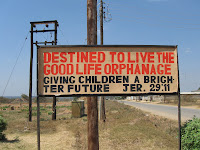 As a project manager in a corporation I work on a wide variety of projects. All are important, most are enjoyable experiences, and all connect me with new people. But no project in my personal history has captivated me like the Destined to Live the Good Life Orphanage project in Kitwe, Zambia.
As a project manager in a corporation I work on a wide variety of projects. All are important, most are enjoyable experiences, and all connect me with new people. But no project in my personal history has captivated me like the Destined to Live the Good Life Orphanage project in Kitwe, Zambia.  The story is only at the beginning and far from complete, but already an inspiring one. It is a journey as they say, one that will evolve over the next several years. Pastors Deborah and Steve Powell have been traveling to Kitwe for seventeen years, and founded the orphanage several years ago. With no facility they placed children in host homes to provide security and nurturing. In the summer of 2010 they were able to open the first phase of a facility with thirty residents. The emotional, spiritual and intellectual growth of these children, aged three to fifteen years at the time, has been breathtaking. With the security and education provided by the orphanage they have gained new confidence and a new vision for their future. And that is what it is really all about, isn't it?
The story is only at the beginning and far from complete, but already an inspiring one. It is a journey as they say, one that will evolve over the next several years. Pastors Deborah and Steve Powell have been traveling to Kitwe for seventeen years, and founded the orphanage several years ago. With no facility they placed children in host homes to provide security and nurturing. In the summer of 2010 they were able to open the first phase of a facility with thirty residents. The emotional, spiritual and intellectual growth of these children, aged three to fifteen years at the time, has been breathtaking. With the security and education provided by the orphanage they have gained new confidence and a new vision for their future. And that is what it is really all about, isn't it? About three years ago I proposed an alternative way of constructing the orphanage. At this point it appears that the development will be more traditional, but that is not the point. That initial thought motivated investigation, new enthusiasm, and a series of new connections. It was the beginning of a journey that is leading us to a place none of us imagined.
About three years ago I proposed an alternative way of constructing the orphanage. At this point it appears that the development will be more traditional, but that is not the point. That initial thought motivated investigation, new enthusiasm, and a series of new connections. It was the beginning of a journey that is leading us to a place none of us imagined. Last Monday afternoon I joined Deborah in presenting the vision, mission and goals of the orphanage and project to the design studio class at the University of Southern California (USC) School of Architecture. Under the much appreciated auspices of Professors Alice Kimm and Eui-Sung Yi, the studio class has adopted our project for the semester. The end deliverable will be a set of master plans for the continuing development of the orphanage.
Last Monday afternoon I joined Deborah in presenting the vision, mission and goals of the orphanage and project to the design studio class at the University of Southern California (USC) School of Architecture. Under the much appreciated auspices of Professors Alice Kimm and Eui-Sung Yi, the studio class has adopted our project for the semester. The end deliverable will be a set of master plans for the continuing development of the orphanage.
It was an amazing experience. While funding for the development remains a goal, we see USC's engagement as evidence that we are moving in the right direction. Future plans include completion of master plans and construction documents, a field trip to investigate site conditions, and pre-construction activities leading up to development. When complete the initial phase of the new development will support one hundred residents with housing, education, a medical clinic, and the ability to be partially self-supporting through agriculture and trade.
A key goal of this project is to create a new model for developing orphanages. A model that is simple yet which provides high quality services. A model that is affordable in order to improve financial stability. A model that engages and teaches local townspeople, giving them new skills and helping them improve their lives and future. A model that can be duplicated by many people in many places.
In early work the students have been investigating similar types of projects in similar climatic and economic environments. Understanding how to design facilities and systems that are relevant to context, supportable by local workers, sustainable both environmentally and operationally, and which further the goals of the orphanage is an important goal of this research effort. What they have developed in the short time since the start of the semester is striking.
There are several things to be learned even at this early stage of the project. Good ideas often take time to mature and require faith to proceed. Good ideas attract good people, who then adapt the vision and help make it better than it was. Good ideas create positive change, and a new future.
Destined to Live the Good Life. It doesn't get much better than that, does it?
Stay tuned for periodic updates as we progress.




